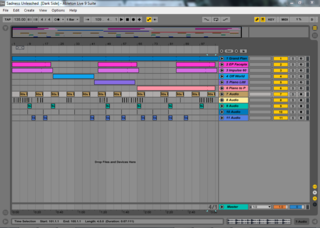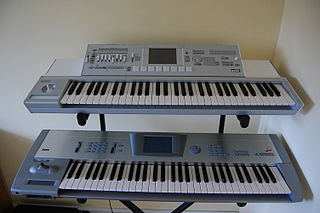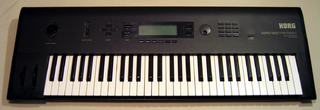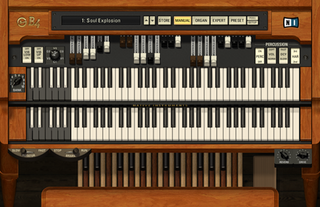
FL Studio is a digital audio workstation (DAW) developed by the Belgian company Image-Line. It features a graphical user interface with a pattern-based music sequencer. It is available in four different editions for Microsoft Windows and macOS.
Steinberg Media Technologies GmbH is a German musical software and hardware company based in Hamburg. It develops music writing, recording, arranging, and editing software, most notably Cubase, Nuendo, and Dorico. It also designs audio and MIDI hardware interfaces, controllers, and iOS/Android music apps including Cubasis. Steinberg created several industry standard music technologies including the Virtual Studio Technology (VST) format for plug-ins and the ASIO protocol. Steinberg has been a wholly owned subsidiary of Yamaha since 2005.

Virtual Studio Technology (VST) is an audio plug-in software interface that integrates software synthesizers and effects units into digital audio workstations. VST and similar technologies use digital signal processing to simulate traditional recording studio hardware in software. Thousands of plugins exist, both commercial and freeware, and many audio applications support VST under license from its creator, Steinberg.

GarageBand is a software application by Apple for macOS, iPadOS, and iOS devices that allows users to create music or podcasts. GarageBand was originally released for macOS in 2004 and brought to iOS in 2011. The app's music and podcast creation system enables users to create multiple tracks with pre-made MIDI keyboards, pre-made loops, an array of various instrumental effects, and voice recordings.
Emagic was a music software and hardware company based in Rellingen, Germany and a satellite office in Grass Valley, California. On July 1, 2002 Emagic was bought by Apple Computer. Emagic's Windows-based product offerings were discontinued on September 30, 2002.

The Roland D-50 is a synthesizer produced by Roland and released in April of 1987. Its features include digital sample-based subtractive synthesis, on-board effects, a joystick for data manipulation, and an analog synthesis-styled layout design. The external Roland PG-1000 (1987) programmer could also be attached to the D-50 for more complex manipulation of its sounds. It was also produced in a rack-mount variant design, the D-550, with almost 450 user-adjustable parameters.

Novation Digital Music Systems Ltd. is a British musical equipment manufacturer, founded in 1992 by Ian Jannaway and Mark Thompson as Novation Electronic Music Systems. Today the company specializes in MIDI controllers with and without keyboards, both analog and virtual analog performance synthesizers, grid-based performance controllers, and audio interfaces. At present, Novation products are primarily manufactured in China.

Ableton Live, also known as Live or sometimes colloquially as "Ableton", is a digital audio workstation for macOS and Windows developed by the German company Ableton.

The Korg Triton is a music workstation synthesizer, featuring digital sampling and sequencing, released in 1999. It uses Korg's "HI Synthesis" system and was eventually available in several model variants with numerous upgrade options. The Triton became renowned as a benchmark of keyboard technology, and has been widely featured in music videos and live concerts. At the NAMM Show in 2007, Korg announced the Korg M3 as its successor.
Reaktor is a graphical modular software music studio developed by Native Instruments (NI). It allows musicians and sound specialists to design and build their own instruments, samplers, effects and sound design tools. It is supplied with many ready-to-use instruments and effects, from emulations of classic synthesizers to futuristic sound design tools. In addition, more than 3000 free instruments can be downloaded from the growing User Library. All of Reaktor's instruments can be freely examined, customized, or taken apart; Reaktor is a tool that effectively encourages reverse engineering. The free, limited version called Reaktor Player is a software that allows musicians to play NI-released Reaktor instruments, but not edit or reverse-engineer them.

The Korg OASYS is a workstation synthesizer released in early 2005, 1 year after the successful Korg Triton Extreme. Unlike the Triton series, the OASYS uses a custom Linux operating system that was designed to be arbitrarily expandable via software updates, with its functionality limited only by the PC-like hardware.

Waldorf Music is a German synthesizer company. They are best known for the Microwave wavetable synthesizer and Blofeld virtual analogue synthesizer.

The Korg MS-20 is a patchable semi-modular monophonic analog synthesizer which Korg released in 1978 and which was in production until 1983. It was part of Korg's MS series of instruments, which also included the single oscillator MS-10, the keyboardless MS-50 module, the SQ-10 sequencer, and the VC-10 Vocoder. Additional devices included the MS-01 Foot Controller, MS-02 Interface, MS-03 Signal Processor, and MS-04 Modulation Pedal.

The RolandJuno-60 is an analog synthesizer manufactured by the Roland Corporation between 1982 and 1984. It followed the Juno-6, an almost identical synthesizer released months earlier. The Juno synthesizers introduced Roland's digitally controlled oscillators, allowing for greatly improved tuning stability over its competitors.

The Korg Wavestation is a vector synthesis synthesizer first produced in the early 1990s and later re-released as a software synthesizer in 2004. Its primary innovation was Wave Sequencing, a method of multi-timbral sound generation in which different PCM waveform data are played successively, resulting in continuously evolving sounds. The Wavestation's "Advanced Vector Synthesis" sound architecture resembled early vector synths such as the Sequential Circuits Prophet VS.
The Roland Alpha Juno is a series of analog polyphonic synthesizers introduced by Roland Corporation in 1985. The Alpha Juno 1 and Alpha Juno 2 were released at the same time, and feature the same sound engine but with the latter boasting additional performance features. The Alpha Junos were a departure from their predecessor, the Roland Juno-106, as they replaced the dedicated controls with soft touch buttons and a single dial for programming sounds. One of the factory presets, nicknamed a 'hoover sound', became a staple in jungle and rave music.

The B4 Organ II is a discontinued commercial, proprietary software synthesizer made by Native Instruments. The software runs as a stand-alone executable, or as a VST, DXi, or RTAS plugin in a Digital audio workstation. The software is an example of a "Clonewheel organ", an attempt at recreating the sound of a Hammond organ using software synthesis.

Massive is a commercial wavetable software synthesizer plugin manufactured by Native Instruments for use in professional audio production. It utilizes several wavetables and oscillators in the creation of synthetic timbres. The software can be used as a VST plugin within a digital audio workstation, or as a standalone program. Released in 2006, the plugin has gained widespread popularity in the electronic music field, and is one of the most popular synthesizer plugins for modern dance music production.

Magnus Choir is a commercial, proprietary music software synthesizer, for the Microsoft Windows and macOS operating systems, written by Daniel Laiseca and developed by Syntheway Virtual Musical Instruments. The first version was released in 2005.

Synth1 is a software synthesizer designed by KVR user Daichi. It was originally designed as an emulation of the Nord Lead 2 synthesizer, and has since become a unique Virtual Studio Technology instrument and one of the most downloaded VST plug-ins of all time. The software used to be a DirectX instrument plugin, but became solely VSTi from version 1.08 on. Version 1.13 was the first version to introduce a native 64-bit version of the plugin.
















